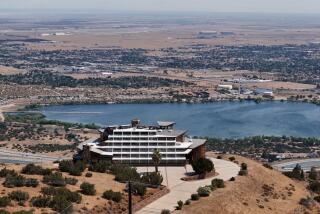End of the Road : Standoff: Vietnam veteran threatens to defy eviction notice, while Caltrans gears up to build new freeway in Oceanside.
Funny thing is, Randy Hollinshead doesn’t look like the little old granny type, rocking on her front porch with a rifle cradled in her lap, protecting her homestead from the Government Man.
But he is.
Hollinshead is a strapping 42-year-old Vietnam veteran taking a last-stand approach either to keep his home of two years from being razed for a freeway or to get enough money to buy a house with similar amenities.
Caltrans officials say the acquisition of Hollinshead’s cozy four-bedroom Oceanside house overlooking the San Luis Rey River valley is being done in the name of progress. The proposed California 76 bypass, they reason, will help alleviate the nerve-wracking rush-hour traffic jams that now plague both Hollinshead and his neighbors.
Randy Hollinshead doesn’t see it that way. Despite a court order, the unemployed construction worker says he is staying put, claiming that officials will have to bodily move him out.
“I’m a veteran who has survived all the niceties of Vietnam, a lot of financial hardships and a lot of other crap,” said the Los Angeles native. “I mean, I have been a renter all my life. And here I get my first break in a lot of years to buy into a house down here in San Diego. Now, they want to come along and just take it away from me, just like that.
“Well, I like being a homeowner. And I’m not budging.”
The stage is set for a showdown Sept. 1, when officials plan to serve an eviction notice at the property on Walton Street about a mile east of Interstate 5. Caltrans officials say they are prepared to have Hollinshead removed by force, if necessary.
“I’m certainly not going to be the one to move him out, but, one way or another, he will have to go--either through the use of U.S. marshals or the state police,” said Gary Klein, the freeway’s project manager.
Caltrans officials said the highway project, scheduled to begin next June, will result in a four-lane expressway running 2.9 miles along the San Luis Rey River east from Hill Street and I-5 to Fousat Road and Mission Avenue.
The new freeway will reroute traffic from California 76, easing the tie-ups that plague the road each rush hour.
Caltrans spokesman Kyle Nelson said the original route proposed for the freeway ran along the floor of the river valley. But concern expressed by environmentalists over the fate of area wildlife--especially an endangered bird called the least Bell’s vireo--forced officials to move the proposed route along the south wall of the valley.
The new path would cut into the back yards of several homes that sat along the ridge of the river valley in a neighborhood known as Oceanside Terrace. In all, officials were required to purchase 67 parcels along the new route, several of them in Hollinshead’s neighborhood.
So far, Nelson said, no other homeowner has stubbornly decided to defend his stake. Only Hollinshead.
“The way we look at it, we know we’re not just moving people out of their houses--it’s their homes,” Nelson said. “So we try to work with them in every way we can, because we’re basically just kicking them out.
“But there are state and federal rules we have to follow to the letter in such cases of right-of-way acquisition. We don’t have an open pocketbook.”
Hollinshead insists that officials are not making a fair offer on the home that he says took him half a lifetime to land.
In April, Caltrans began eminent domain proceedings against the homeowner in Vista Superior Court, offering Hollinshead $133,000 after sending appraisers to assess the one-third-acre property. He purchased the home for $113,400.
Officials have also offered a package to help Hollinshead with his moving and storage expenses until he finds a new residence. They also have offered him opportunities to buy other, more expensive homes farther inland for the price he is being offered.
Nothing doing, says the homeowner, who claims that he has invested more than $11,000 in the place and has spent two years paying his mortgage at a monthly rate of $1,090.
Since he is unemployed, Hollinshead said, he would have little chance of securing another mortgage. All he is asking is that officials find him a similar home with the amenities he now enjoys--most importantly, including a canyon back yard and an ocean view--for a fair swap.
Or, he says, the state is free to pay him outright what he says it would cost to replace his present setting anywhere else. His asking price: $180,000 or more.
“I’m just a construction worker, and an unemployed one at that,” said Hollinshead, a muscular man with a bushy mustache and husky voice. “There is no way I can afford to buy another house like the one I’ve got here. I have built enough of them for people, but I can’t afford one of my own. This house is all I’ve got.”
Nelson said that, although the government’s current policy of land acquisition might seem unfair, officials must abide by laws that protect homeowners from the large-scale government land grabs of the past.
“We admit, what’s happening to Mr. Hollinshead generally is not fair,” Nelson said. “But this freeway is going to be a good thing for a lot of people. How do you balance the needs of the individual versus the needs of society?
“In the end, he just happened to buy the wrong place at the wrong time.”
Hollinshead bought his house sight unseen in February, 1990. He was working in Northern California at the time when a bartender friend called him with details about this neat little fixer-upper down in Oceanside.
He sent his buddy a $500 check to put the house into escrow.
The way Hollinshead saw it, the site was perfect for one day building a two-story dream house with a wonderful view of the sea and the valley below. In the meantime, he tinkered on weekends around his house and yard, which is littered with several boats, campers and other assorted belongings.
Not long after he moved in, neighbors reported seeing surveyors in the neighborhood. But most assured Hollinshead that the road project, in the planning stages for a decade, would never be built.
They were wrong.
This spring, Hollinshead began receiving letters announcing that the state planned to acquire his property. He ripped the letters up. “The house,” he said, “was not for sale.”
Then the relocation teams began showing up at his door. Hollinshead said he politely told them that he wasn’t interested. When one worker banged on his bedroom window from the back yard, he threatened to call the police.
Meanwhile, the neighboring homes along the south wall of the valley began to disappear as about 18 other homeowners gave up their properties and moved away. Soon afterward, their houses were torn down.
Although he said he could not afford to hire an attorney, Hollinshead sought enough legal advice to file a general denial notice with the courts, effectively saying that he wasn’t going to sell.
In June, a judge granted the state an order for possession against Hollinshead. Not long afterward, he received notice to vacate the property by Sept. 1.
In his darker moments, Hollinshead says he figures he has lost the immediate war, that officials will eventually take his house and tear it down. But he plans to pursue the matter in court, in the hope that a judge or jury will award him what he wants for his house.
Caltrans officials say they are also prepared to go to court.
“If the courts decide that Mr. Hollinshead’s home is worth more than we’ve offered, then we were wrong,” highway project supervisor Klein said. “We’re not always right.”
Meanwhile, Hollinshead is ready for his September showdown with the Government Man.
“I’ll be here when the marshals arrive,” he said. “It’s too bad that it’ll have to come to that. I don’t want to break any laws. But I don’t want them to get away with anything either.”
More to Read
Sign up for Essential California
The most important California stories and recommendations in your inbox every morning.
You may occasionally receive promotional content from the Los Angeles Times.











